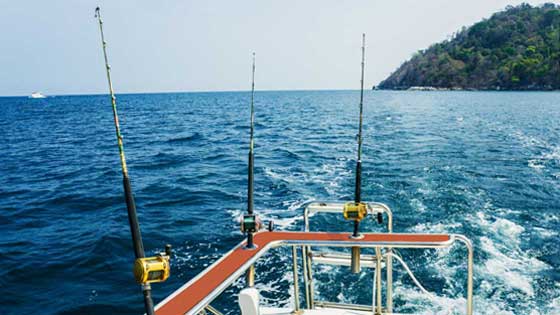Striped Bass Deep Water Fishing

During the day, Striped Bass enjoy the safety of the deep and only come to the surface at night, especially during hot summer months along the southern US coast.
- they enjoy feeding along the edges or drop offs
- stripers also prefer oxygenated waters
Where landlocked, these areas can be the mouths of rivers. Young Striped Bass don’t head into deep water until later summer. In some locations Stripers are relegated to reservoirs and lakes that don’t allow for normal migration and spawning, but they still look for the well-oxygenated thermocline in the deep that both prey and stripers dwell.
Trolling, Casting, Fly Fishing
Catching striped bass in deep water can be done by trolling, spinning, casting and fly casting. While these techniques can work at night, they work best during the day.
If you’re wanting to fish at night, click here fishing for Striped Bass in the shallows.
Trolling for stripers
A tool that’s helpful when fishing from a boat is the use of an electric motor because it creates very little noise to scare away the fish.
These fish swim throughout a lake and are hard to track at most times during the striper season.
While a depth finder will locate striped bass, they don’t remain in one area for long. It’s better to understand the movement of the thermocline as this knowledge will prove more successful and enable you to better use a sonar and catch stripers.
- Try starting with drop-offs, in the lower half of the lake, along river channels, over submerged islands and ridges in the thermocline layer
- Troll using a crank bait or a live shad
- Use live shad and minnow bait or large jigs along dams at depths of 20 to 40 feet
Catching stripers from the shore
Striped bass fishing usually requires a depth finder and temperature indicator.
The exception is in late spring, when the best striper fishing is often from shore and at night.
Around the same time that stripers are returning to the lake from smaller streams, schools of gizzard and threadfin shad begin to spawn nightly in the shallow bays. Stripers ambush the spawning shad from deep water, intercepting the schools as they move into shallow water to spawn.
Night lake fishing for large Striped Bass usually requires heavy spinning equipment and 20lb test line.
- Cast a deep-running crank bait parallel to the shore in a rocky area that features a 10 or 20 foot drop-off
- Pace the lure at a medium speed to ensure the lure maintains its maximum depth
- At night, fishing lures for striped bass should be loud. Rattle crankbaits filled with splitshot attract both stripers and impressively sized largemouth’s
About the Thermocline
When fishing from a boat in summer, some anglers use temperature indicators to find the cool, oxygen-rich, thermocline layer of water. The layer above the thermocline, called the epilimnion, is warm and low in oxygen content.
Equally, the hypolimnion layer below the thermocline is cold and low in oxygen content.
The oxygen-rich thermocline layer cools as the water deepens, and attracts many varieties of fish. Try to position your lures in the fish-filled thermocline layer.



